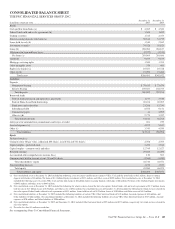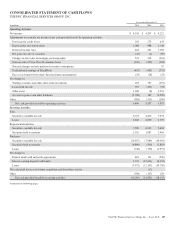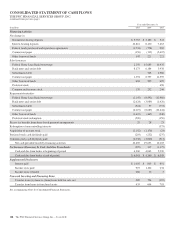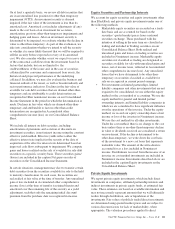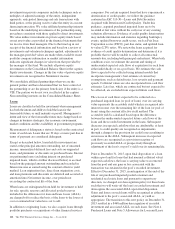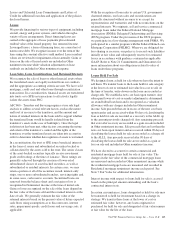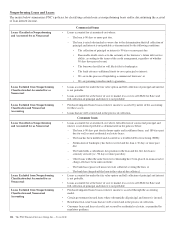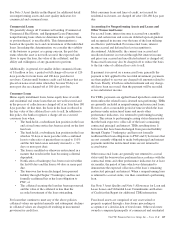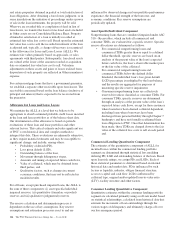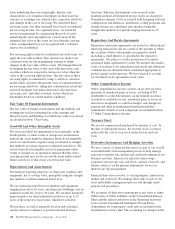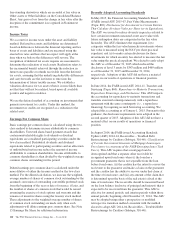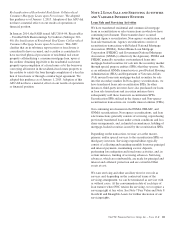PNC Bank 2015 Annual Report Download - page 133
Download and view the complete annual report
Please find page 133 of the 2015 PNC Bank annual report below. You can navigate through the pages in the report by either clicking on the pages listed below, or by using the keyword search tool below to find specific information within the annual report.See Note 3 Asset Quality in this Report for additional detail
on nonperforming assets and asset quality indicators for
commercial and consumer loans.
Commercial Loans
We generally charge off Commercial Lending (Commercial,
Commercial Real Estate, and Equipment Lease Financing)
nonperforming loans when we determine that a specific loan,
or portion thereof, is uncollectible. This determination is
based on the specific facts and circumstances of the individual
loans. In making this determination, we consider the viability
of the business or project as a going concern, the past due
status when the asset is not well-secured, the expected cash
flows to repay the loan, the value of the collateral, and the
ability and willingness of any guarantors to perform.
Additionally, in general, for smaller dollar commercial loans
of $1 million or less, a partial or full charge-off occurs at 120
days past due for term loans and 180 days past due for
revolvers. Certain small business credit card balances that are
placed on nonaccrual status when they become 90 days or
more past due are charged-off at 180 days past due.
Consumer Loans
Home equity installment loans, home equity lines of credit,
and residential real estate loans that are not well-secured and
in the process of collection are charged-off at no later than 180
days past due. At that time, the basis in the loan is reduced to
the fair value of the collateral less costs to sell. In addition to
this policy, the bank recognizes a charge-off on a secured
consumer loan when:
• The bank holds a subordinate lien position in the loan
and a foreclosure notice has been received on the first
lien loan;
• The bank holds a subordinate lien position in the loan
which is 30 days or more past due with a combined
loan to value ratio of greater than or equal to 110%
and the first lien loan is seriously stressed (i.e., 90
days or more past due);
• The loan is modified or otherwise restructured in a
manner that results in the loan becoming collateral
dependent;
• Notification of bankruptcy has been received within
the last 60 days and the loan is 60 days or more past
due;
• The borrower has been discharged from personal
liability through Chapter 7 bankruptcy and has not
formally reaffirmed his or her loan obligation to
PNC; or
• The collateral securing the loan has been repossessed
and the value of the collateral is less than the
recorded investment of the loan outstanding.
For loans that continue to meet any of the above policies,
collateral values are updated annually and subsequent declines
in collateral values are charged-off resulting in incremental
provision for credit loss.
Most consumer loans and lines of credit, not secured by
residential real estate, are charged off after 120-180 days past
due.
Accounting for Nonperforming Assets and Leases and
Other Nonaccrual Loans
For accrual loans, interest income is accrued on a monthly
basis and certain fees and costs are deferred upon origination
and recognized in income over the term of the loan utilizing
an effective yield method. For nonaccrual loans, interest
income accrual and deferred fee/cost recognition is
discontinued. Additionally, the current year accrued and
uncollected interest is reversed through Net interest income
and prior year accrued and uncollected interest is charged-off.
Nonaccrual loans may also be charged-off to reduce the basis
to the fair value of collateral less costs to sell.
If payment is received on a nonaccrual loan, generally the
payment is first applied to the recorded investment; payments
are then applied to recover any charged-off amounts related to
the loan. Finally, if both recorded investment and any charge-
offs have been recovered, then the payment will be recorded
as fee and interest income.
For TDRs, payments are applied based upon their contractual
terms unless the related loan is deemed non-performing. TDRs
are generally included in nonperforming and nonaccrual loans.
However, after a reasonable period of time in which the loan
performs under restructured terms and meets other
performance indicators, it is returned to performing/accruing
status. This return to performing/accruing status demonstrates
that the bank expects to collect all of the loan’s remaining
contractual principal and interest. TDRs resulting from 1)
borrowers that have been discharged from personal liability
through Chapter 7 bankruptcy and have not formally
reaffirmed their loan obligations to PNC and 2) borrowers that
are not currently obligated to make both principal and interest
payments under the restructured terms are not returned to
accrual status.
Other nonaccrual loans are generally not returned to accrual
status until the borrower has performed in accordance with the
contractual terms and other performance indicators for at least
six months, the period of time which was determined to
demonstrate the expected collection of the loan’s remaining
contractual principal and interest. When a nonperforming loan
is returned to accrual status, it is then considered a performing
loan.
See Note 3 Asset Quality and Note 5 Allowances for Loan and
Lease Losses and Unfunded Loan Commitments and Letters
of Credit in this Report for additional TDR information.
Foreclosed assets are comprised of any asset seized or
property acquired through a foreclosure proceeding or
acceptance of a deed-in-lieu of foreclosure. Other real estate
owned is comprised principally of commercial and residential
The PNC Financial Services Group, Inc. – Form 10-K 115


